
When Sustainable Blue CEO Kirk Havercroft drives home from the company’s facility in Nova Scotia, just a half mile (800 meters) from the Bay of Fundy’s Minas Basin, he passes cow pastures, a red-roofed community center, barns and siloes, feed mills, farm stands that sell blueberries and corn in season, vineyards, and white farm houses. It’s the type of place where people want to protect the land and water.
Dependent upon agriculture, fishing, and tourism, this part of Nova Scotia’s Annapolis Valley might be averse to a recirculating aquaculture system (RAS) with even a small amount of nitrate-laden discharge. But, in the case of Sustainable Blue, there isn’t any.
The creator of this proprietary technology Dr. Jeremy Lee introduced it to Nova Scotia in 2007 from the United Kingdom, where he had developed water treatment systems for both aquaculture and the country’s largest aquarium.
He and Havercroft launched a pilot plant in Centre Burlington in 2010. Now, after more than a decade of refining and scaling, the company is scouting for a new site in Washington state following a breakthrough deal last spring with Commissioner of Public Lands Hilary Franz, who had issued an executive order prohibiting commercial finfish net pen aquaculture in state waters in November 2022.
According to Max Showalter, policy advisor at the Washington State Department of Natural Resources (DNR), “Sustainable Blue’s zero-discharge recirculating aquaculture system (zRAS) makes it a sustainable alternative for salmon aquaculture in Washington by eliminating opportunity for escape and minimizing pathogenic threats to fish.”
In an email, he emphasized, “The success of Sustainable Blue’s facility in Nova Scotia demonstrates their commitment to raising healthy, nutritious salmon with minimal environmental impact.”
The agreement has raised some eyebrows, however. The Northwest Aquaculture Alliance, a membership organization, told Aquaculture North America, “The entire aquaculture industry is baffled at how one small tank fish farming company from Nova Scotia was secretly handed an exclusive business partnership agreement for state-owned public lands by Commissioner Franz. There was no public call for proposals issued by the DNR and Commissioner Franz.” What’s more, a Washington superior court judge has now ruled that Franz’s order “lacks legal operative effect,” so there is currently no net pen ban.
No discharge – how?
Havercroft does not detail how the company is able to recirculate 100 percent of its water, with no discharge into the environment, except to say that the “technology is based on a process which is unique in its application to land-based aquaculture.”
He did add that “a new theory of RAS filtration” — as opposed to conventional RAS which, in part, typically removes solids with mechanical screen filtration — “forced the company down the route of designing, engineering, and constructing its own treatment system to deliver this newly applied process at the heart of the filtration system.
“Nobody was doing that at the time that this early research began and nobody’s doing it now,” he continued. “Our process is a closely guarded secret.”
The company deliberately opted not to patent it to avoid putting the concept into the public domain and having to defend its rights. In addition, “fairly robust” non-disclosure agreements are part of employment contracts for the 27 full-time staff, Havercroft said.
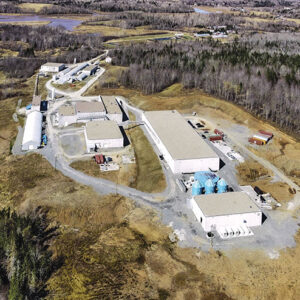
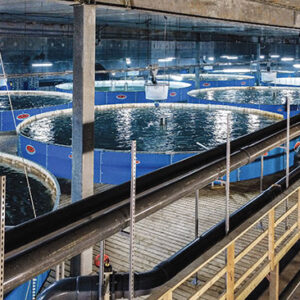
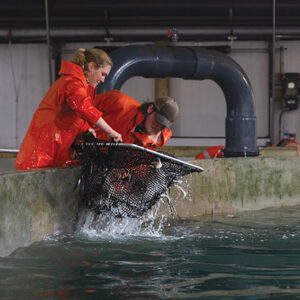
Gearing up the technology
Prior to Sustainable Blue, Lee had extensive experience in developing, manufacturing, and installing water treatment systems for marine and freshwater fish farms and hatcheries. He currently has a 75 percent stake in UK-based Blue Tech Systems International, which provides technology expertise to Sustainable Blue.
In May, Lee told Sustainability Magazine that, going back to 2016, the company had begun preparing the system to manage risk as it scaled. To develop a “control solution” that could be “self-sustaining,” Blue Tech tapped UK-based system integrator Fairfield Control Systems, along with Intelligent Motor Control technology from Rockwell Automation.
Looking at an aerial view of Sustainable Blue’s facility today, one can also see the company’s incremental approach to growth over time. “We literally pushed that pilot plant facility to its limits, pulling out all of the very best ideas and making improvements for the second generation. The third generation was to scale all of that up to a commercially sized module that can be repeated as we go forward and contemplate building 5,000 and 10,000 metric ton salmon farms,” Havercroft said.
Under the radar screen
The saltwater grow-out facility that is now producing 40,000 pounds of salmon each week (that is, a capacity of roughly 1,000 metric tons) is “essentially the final scale of production module that we will ever build. And any future Sustainable Blue fish farms will be multiples of these modules strung together,” he said.
Purposely keeping the company small, the leadership team also decided, “Let’s not talk about what we think we will be able to achieve. Let’s wait until we get there. Let’s prove it,” he said.
This know-before-you-grow approach was based on the belief that investors find land-based aquaculture to be interesting, but risky. “Now with future investors, as we contemplate our hopefully significant expansion and growth phase, we can go to them and say, ‘We’re not introducing any more technology or engineering risk into the profile. All we’re doing is scaling something that we’ve already built, costed, and operated to its full biological design load,” Havercroft said.
As if on cue to help propel this commercial take-off, in October, Sustainable Blue received C$500,000 (US$367,200) in funding from the Atlantic Canada Opportunities Agency (ACOA), a governmental program designed to help businesses and other institutions in the region. Among its programs, the ACOA supports businesses “with an R&D element with a strong possibility for commercialization,” according to its website.
A strategic advantage
But an approach based on increasing the number of proven modules is not totally new for RAS producers seeking to build in the US. In Maine, for example, Nordic Aquafarms countered strong local opposition by positioning its proposed US$500 million facility in the context of what the leadership team had learned operating three facilities in Europe and then emphasizing that the Maine facility would be built in stages.
“Scaling is achieved by replicating independent modular systems over several phases of expansion,” the company said in a 2019 statement.
Ultimately, though, the greatest challenges to Nordic Aquafarms hinged on effluence: its perceived threat to water quality and its inability to run pipes through intertidal land after a complex series of lawsuits.
And here Havercroft said that he hopes Sustainable Blue has “a credible, established, and proven project with a very unique strategic advantage potentially over other more conventional RAS farms that have to deal with the waste discharge component.”
But Northwest Aquaculture Alliance is not convinced. “While we commend the Nova Scotia company for cleaning its wastewater and returning it back to the facility, effluent discharge is not a huge environmental challenge,” said spokesperson Jeanne McKnight. “Multiple wastewater treatment processes, from municipal sewers to agriculture systems to freshwater hatcheries, are used globally to turn all kinds of effluent waste into safely dischargeable water.”
Still, as the Environmental Protection Agency notes, nutrient pollution has impacted many streams, rivers, lakes, bays, and coastal waters for the past several decades, resulting in some serious environmental and human health issues. Those impacts have not faded from the public consciousness.
Paul Richer of Fathom Fish & Seafood, Sustainable Blue’s distributor in Canada, thinks this is the case. Citing the fact that the farm has no discharge permits, he said this technology appeals to “consumers who care about sustainably raised salmon with zero impact or very minimal impact on the environment compared to alternatives and who want an option free of any therapeutics.”
On the other hand, NWAA, whose membership spans the gamut of aquaculture producers, points out, “The most significant environmental concern around using RAS methods for shore-based finfish farming is the much larger amount of electricity required to grow fish to harvestable size. Unfortunately, as it stands today, twice the number of GhGs are emitted growing salmon in a RAS system vs. ocean-based salmon farming, which is well-documented as having the lowest carbon footprint of any form of farmed animal protein. For RAS operations based in Nova Scotia, this is even more of a challenge, where 43 percent of electricity is generated by coal-fired plants, according to the Nova Scotia Power utility Emera.”
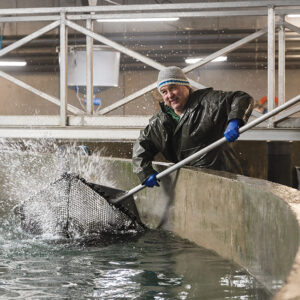
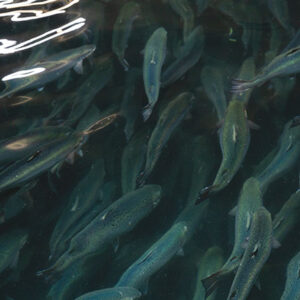
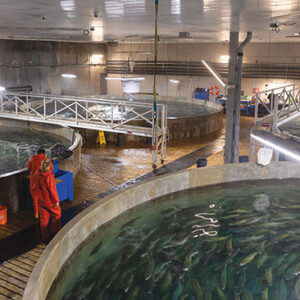
Washington bound
One person who does endorse land-based aquaculture is environmentalist Yvon Chouinard, the founder of Patagonia, which has produced films denouncing salmon farming in the ocean. And, according to a story published by Forbes in 2019, Chouinard is an investor in Sustainable Blue.
“We do know that Franz is arm-in-arm with the 501c3 nonprofit organization, the Wild Fish Conservancy (WFC), which is financially backed by Yvon Chouinard,” McKnight asserted, tying the Washington commissioner to the investor-philanthropist.
Whoever and however the road from Nova Scotia to Washington has been paved, Sustainable Blue is now working with the DNR to explore potential parcels from among the portfolio of state-owned lands it manages, which includes 2.6 million acres of aquatic lands.
If Sustainable Blue finds land that meets its criteria, it will begin “the standard leasing process,” during which the DNR will review any competing applications to lease the same parcel, according to Showalter. (“Any group is welcome to express interest to lease parcels from DNR as part of the standard leasing process by submitting an application,” he added.) Depending upon the parcel, lease revenue could go to school construction, state institutions, counties, or local fire districts.
After that, the process begins for Sustainable Blue to obtain permits for construction and operation from the DNR and other regulatory or management agencies.
For now, though, Sustainable Blue is still in the site evaluation phase, ranking, prioritizing, and visiting parcels of land. “We’d like to have at least a dozen options on the list before we actually pick one,” said Havercroft, noting that the criteria include proximity to the ocean, soil that can be dug for underground pipework, and three-phase electrical power.
But one goal has already been met: “It’s such a tremendous partnership opportunity because we get to locate in a jurisdiction which publicly values conservation,” he said.
Print this page
